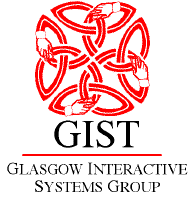
Multimodal Interaction Group
Home
Research
Conferences and workshops
Group publications
Demos
Links
Jobs available in the Group
HCI teaching
Research Student Committee
Workshop on
Haptic Human-Computer Interaction
31st August to 1st September, 2000
Senate Room
University of Glasgow
Glasgow, Scotland
The workshop has now taken place. We had around 75 participants from 10 different countries with attendees from both academia and industry. It was a great success - it brought together a really wide range of people from artists to psychologists and engineers to textiles specialists.
The proceedings of the workshop have been published by Springer.
Haptic research in Computing Science at Glasgow
The follow-on ot this workshop will be the Europhaptics conference in Birmingham, July 2001.
Aims and objectives of the workshop
Haptic devices allow users to feel their interfaces and interactions and have the potential to radically change the way we use computers. We will be able to use our powerful sense of touch as an alternative mechanism to send and receive information in computer interfaces. Haptic technology is now maturing and coming out of research laboratories and into real products and applications. We can therefore begin to focus on its application and general principles for its use rather than just the hardware and technology itself. One important question is what should it be used for?
The aim of the workshop is to concentrate on interaction using haptic devices. Haptic interaction is interaction related to the sense of touch - this could be based on force-feedback or tactile devices. We want to be as flexible as possible so we will accept work on any aspects of haptic HCI. There are other conferences that discuss the hardware but so far there has been little discussion of how haptics can be effectively used to improve the usability of human-computer interactions.
What are haptics good for? What kind of information can be successfully presented via touch? Do haptics actually improve efficiency, effectiveness and satisfaction? Arbitrary combinations of information presented to different senses have been shown to be ineffective. How should sight, hearing and touch be combined in truly multimodal interfaces? We do not want to end up with haptically-enhanced interfaces that are in fact harder to use than standard ones - haptics may become just a gimmick for computer games, rather than the key improvement in interaction technology that it should be. It is therefore time to think about haptic human computer interaction.
The is currently no unified place to present research on general haptic human-computer interaction and so one aim of this workshop is to provide an infomation resource for those interested in the area.
The workshop
Here is the final programme of the workshop - you can download the full text of all of the papers and posters from here. The workshop took place in the Senate Room at the University of Glasgow just before BCS HCI 2000 in Sunderland. Here is a map to show you the location of the Senate Room.
Here is a full list of those who attended the workshop. This is more up to date than the attendee list in the proceedings as several people registered at the last minute.
Here are some photographs of the workshop and social events.
Other activities
A mail list for those who attended the workshop has now been set up. If you wish to be added to it then please email Steve Brewster.
We need to decide whether or not there should be another workshop (and if so, who should organise it). One alternative is the Eurohaptics conference that might take on the role.
Registration and accommodation
For full details go to the registration page. The travel page will tell you how to get to the University of Glasgow.
Contact
Stephen Brewster
Department of Computing Science,
University of Glasgow,
Glasgow G12 8QQ, UKe-mail: stephen@dcs.gla.ac.uk
phone: +44 (0)141 330 4966
fax: +44 (0)141 330 4913
Programme Committee
Stephen Brewster and
Roderick Murray-Smith (joint
programme chairs), Department of Computing science, University of Glasgow
Gunar Jansson, Dept of
Psychology, Uppsala University
Alan Wing, Dept of Psychology,
University of Birmingham
Frank Pollick, Dept of Psychology,
University of Glasgow
Timothy Miller, Dept of Computer
Science, Brown University
Ken Hunt, Dept of Mechanical
Engineering, University of Glagow
Christine MacKenzie, School
of Kinesiology, Simon Fraser University
Helen Petrie, Dept of Psychology,
University of Hertfordshire
Shumin Zhai, IBM Almaden
Research Center
Chris Hasser, Immersion Corporation
Bob Stone,
Ben Bishop, Virtual Presence Ltd
Stephen Furner, BT Advanced
Communication Research
William Harwin, Dept
of Cybernetics, Reading Universty
Roberta Klatzky, Carnegie
Mellon University
Organisation: Marilyn McGee, Ian Oakley, Andrew Crossan, Ray Wai Yu, Dept of Computing Science, University of Glasgow.
|
Dr Stephen Brewster
Department of Computing Science
University of Glasgow
Glasgow, G12 8QQ, UK
Tel: +44 (0)141 330 4966
Fax: +44 (0)141 330 4913
Email: stephen@dcs.gla.ac.uk
Last Modified: July 12, 2001
